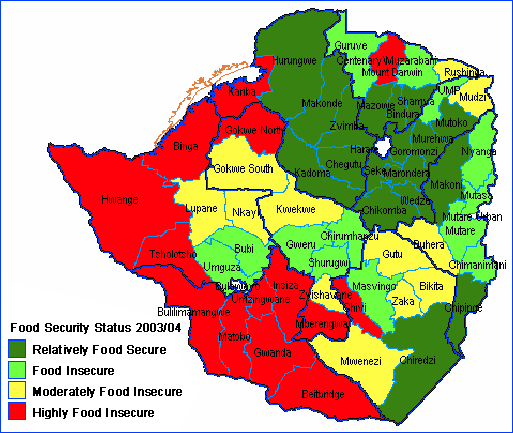
|

Food Security Emergency
Issued: June 3, 2003
The Famine Early Warning Systems Network (FEWS NET) issues periodic emergency alerts when a significant food security crisis is
occurring, where portions of the population are now, or will soon become, extremely food insecure and face imminent famine. Decision
makers should give the highest priority to responding to the situations highlighted by this Emergency alert. Website: http://www.fews.net
|
|
|
[Complete version  - 82Kb < 1min (1 pages)]
[ Share with a friend - 82Kb < 1min (1 pages)]
[ Share with a friend  ]
]
|
Zimbabwe: In spite of the harvest, extreme food insecurity persists in the south and extreme north.
SUMMARY
- Early harvesting of the 2002/03 food crops (maize, millets and
sorghum) has improved cereal availability for a significant number
of households in rural and urban areas of Mashonaland, Masvingo,
Manicaland and Midlands Provinces. However, given escalating
maize prices compared to diminishing income levels, access
remains an issue for most households in these areas, since many
have experienced three consecutive years of poor harvest.
- The relief that farming households in the central and northern main
cereal growing districts are getting from the 2002/03 cropping
season's harvest is not being shared by households in the southern
and extreme northern Zambezi valley districts of the country where
there is hardly any harvest. These rural households are solely
dependent on food assistance for their survival.
- Unemployment levels and inflation (estimated at 228 percent in
March 2003) continue to skyrocket, while incomes in real terms lag
considerably behind.
- Both food access and supply problems continue to take their toll on urban food security in Zimbabwe. Maize meal, bread and
cooking oil are now available in some of the formal retail outlets, but prices on both the parallel and official markets for these
commodities are prohibitively expensive for most poor urban households.
- WFP is distributing a two month food ration for May and June to 1.3 million people, down from 5 million in April, targeting areas
where there has been total or near-total crop failure.
- The April 2003 Zimbabwe Vulnerability Assessment Committee (VAC) report expected in June will provide a detailed picture of the
needs for the rest of the year.
RECOMMENDED
|

|
Zimbabwe Emergency Timeline
|

|
RECOMMENDED ACTIONS
- The Government and NGOs should embark on agriculture recovery programs to ensure farmers have adequate seed, fertilizer and
draft power when the 2003/04 growing season starts.
- Food aid should continue in the form of relief programs, including free distribution, school and supplementary feeding in the most
affected districts in the south and self targeting food for work programs in the central and northern districts of the country.
- Food aid assistance should be scaled up in innovative ways in urban areas, such as market interventions (including monetization)
and targeted programs directly assisting vulnerable groups (including orphans and HIV/AIDS patients).
- The Government should start planning now to import maize to meet a potential deficit of over 700,000 MT in the 2003/04
consumption year.
For more information see the FEWS NET Zimbabwe Country Center at:
http://www.fews.net/zimbabwe
The Famine Early Warning System Network is an USAID activity managed by Chemonics International Inc.
Contact us at Zimbabwe@fews.net or info@fews.net. Our Harare telephone number is (263-4) 729196.
|
|






